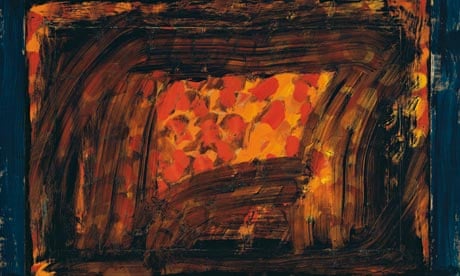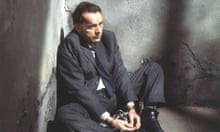It is difficult to look at Howard Hodgkin's paintings without a picture in your mind of where they might hang when they are not on loan to an exhibition. They are haunted by secret worlds, not only that of the artist, but also those of his collectors. They are paintings for and of the private sphere. Only one work in his captivating exhibition of recent work at Modern Art Oxford has been lent from a museum. The rest have come from houses and apartments, from over the mantelpiece or the bed, from a dark office or a bright dining room . . . you see? You start thinking about these absent places, the homes of the paintings, and the images keep coming.
Most suggestive of all is Hodgkin's little painting Leaf (2007-09). It belongs, surely, in a study. I imagine it hanging near the door. The walls around it are crammed with natural history specimens – impaled butterflies, glassed-in stag beetles. Old volumes of Darwin and Linnaeus are on the bookcases. Opposite this painting, in playful juxtaposition, is a microscopically precise 19th-century study of a leaf. Outside, through a window honeyed by the glow of the desk lamp, is an orchard.
Leaf is a perfect miniature of Hodgkin's art. In this small picture he distills everything that is original about his vision. Who else would do what Hodgkin does here, and mimic the genre of the botanical study, yet enfurl that tradition of scientific looking in a baroque robe of abstract green? His leaf is a double swirl of louche colour, a wild brushstroke enclosed in a battered wooden frame. It is not a realistic leaf yet it responds to the visible world – it is the colour of a leaf. It is, we accept, faithful to reality – but how? How does the world so pervade Hodgkin's art that each picture, placed in the dry space of an art gallery, seems to carry with it the intimacy of private rooms, the freshness of gardens, the changing light of nature?
Some artists emerge fully-formed, perfect, from art school, like David Hockney in the 1960s, glittering in a gold jacket and pop spectacles, painting with an open sensuality. Hodgkin, born in 1932, also had his first exhibitions in the early 60s but to look at his early works, to read the reviews of a shared show at the ICA in 1962 with the – then – far more happening Allen Jones, is to excavate a stuttering, uncertain start. The scion of a famous family, an Eton drop-out, he did not look in his first decade of painting like a central figure in the art of his time. Yet I would argue that alone of all his British contemporaries he has remained loyal to the most interesting and serious artistic insights of the 60s. He is conventionally praised, and occasionally dismissed, as the last English romantic, a pure painter in the mould of Constable and Turner, an artist who feels. I see him more as an artist who thinks – a philosophical painter.
To return to that leaf in Oxford. Hodgkin could have dipped his brush in any colour he liked. He mixed a lime or olive-tinged green, that breaks into streaks of yellow against the bare wooden board, leaving oil stains around it and a clogged sticky pool against the frame. It is also, magically, leaf shaped. This single wide brushstroke, doubled up on itself in a bulbous curve, produces the tapering form of a laurel leaf. Then again, the wispy delicacy of the brushstroke – so casual, so light, so airy – suggests a leaf's movement in the air, as if it were about to be blown away on an evening breeze. So he gives us the colour of a leaf, the shape of a leaf: and most importantly, the essence of a leaf, which comes of its slightness, its vulnerability to gusts.
This is a systematic, and to me profoundly moving, rethinking of what it is to see an object. Ideas, associations, affinities, memories, longings consitute, for Hodgkin, our real experience of the material world. When we think of a leaf we may have different memories from his, but we never simply see a constellation of cells. The world comes to us already composed of lyrical suggestions. The most ambitious modern artists have wrestled with this complex web of experience ever since Paul Cézanne stared at Mont Sainte-Victoire and, portraying it again and again, infused every rock, every pine branch with his own isolation and turbulent inwardness. In the 1950s and early 60s the inquiry begun by Cézanne was reformulated by three Americans – Jasper Johns, Robert Rauschenberg and Cy Twombly – and I believe these are the artists of that epochal time with whom we should compare Hodgkin.
When Johns made an American flag of collaged newsprint embalmed in encaustic, he conveyed the plenitude of stories and perspectives an apparently simple icon could hold; when Rauschenberg put his bed, smeared and spattered with paint, on a gallery wall he invited the beholder to read or invent tales of sex and intimacy in its stains. But most of all Hodgkin resembles Twombly, whose graffiti epics speak of dirty sex and high feeling in grand palatial Roman settings. Like Twombly, he has become better as he has become more openly emotional. It was with paintings of the 1980s whose titles, such as In Bed in Venice (1984-8), or Love Letter (1984-88), convey their intimacy, that Hodgkin discovered the eloquent grandeur of his maturity. Neither of these pictures is legible in a realist way: but neither is emptily abstract, either. To engage with them is to be caught in knots and shocks of recognition and imagining: to chase after the artist's encounters and longings. It is in the best intellectual tradition of modern art from Cézanne to Rauschenberg's Bed and Twombly's Ferragosto.
His exhibition of recent work in Oxford reveals that he is still advancing, and still thinking. Lawn (2009), seems to want to show all the potential colours of grass in different lights, at different seasons, or in the varying vitality of different blades in a single bit of turf, within one unified smear of layered colours. Khaki, yellow, pink, grey, pine and moss all twist together in lines of unmixed oil, like a preparation for a giant microscope. At the very beginning of natural history in art stands Albrecht Dürer's 1503 watercolour The Great Piece of Turf. In this mesmerising observation of nature Dürer concentrates his gaze on a tiny section of the world and depicts each blade of grass, each leaf and seed in it with intense accuracy. Hodgkin similarly excavates a cross-section of grass but we have no way of knowing if he has portrayed an entire lawn, or a two-centimetre patch. His painting Big Lawn (2008-10) is broader, as if seen from further away in the soft light of a summer evening, and Sky (2008-09) induces a moment of vertigo just with two alternating blues – dark and light – conveying, in a small golden oval frame, the height and sweep of a Tiepolo heaven. Yet at the same time, and this complicates the show in dark ways, contemporary history intrudes.
Yellow Sky (2010) reveals just a sliver of yellow horizon under an oily mass of brown and black clouds, with towering and falling pillars of paint on the left of the scene that resemble the funnel of a tornado sweeping across America (I imagine), while Dirty Weather (2001) concentrates a terrible storm, or a volcano, or a battlefeild into a miasma of ochre and green and black smoke: it suggests looking through veiled eyes at a dustcloud after an explosion in a nature reserve. But Shadow (2002-03) leaves less room for doubt. Across a bright corn-yellow world towers a black column. It is clearly the shadow of the attacks in New York on 11 September 2001. That shadow streaks across this entire exhibition.
Whatever personal pain is communicated by the exhibition's extraordinary climactic painting, Blood, the violence of this new work (too new to be in the catalogue) is also unmistakably historical. Over a green world, a great sweep of blood gushes up and then arcs and falls – a wave of red, congealing into brown scabs, turning the earth into wet flesh. It is gut-churning. Never has the wetness of his paint seemed so apposite. Part of the seduction of his art is that the colours never seem to dry: the oil keeps its freshness. The wide motions of the brush create a sense of openness and fluency that doesn't stabilise into neat lines, doesn't settle down. But here, in his widescreen epic of war, he turns that vivacity to horror. We seem to be seeing people bleed. The red explodes from severed arteries. It dries on the road. It waters the fields. It is sucked into transparent tubes and mingles with water in a jar.
The sense of green places and blue waters in these paintings of the past 10 years is surely apposite to an age of planetary dread. Like a television documentary about the state of the Earth, but with the authority of paint, his transfigured landscapes and still lifes tell of a nature that is not safe, a life no longer guaranteed, for him or anyone else. Hodgkin is never quite what you think. The giddy colourist is really a daring philosopher, the intimist a public man after all. In the 60s he might have seemed a bit conventional compared with the pop artists but in reality he was thinking his way into a deeply ambitious form of abstract storytelling. The sense of history that shakes his recent paintings has deep roots in his art. In the 80s he collaborated with Susan Sontag on their illustrated story of Aids and its impact, The Way We Live Now. That political, engaged stance was entirely of a piece with his paintings of the time, whose tales of private life – as in for example Lovers (1984-92) – testify to the significance, even the historical weight, of what happens in bed. He still thinks about that. One of the most intense paintings here is a burst of black and red and fire-orange called Privacy and Self-Expression in the Bedroom (2004-06).
What has mattered in Hodgkin's art, and still does, is not simply a brilliant way with colour, although it would be hard to find many painters of the past 100 years who could out-scintillate a work such as that bedroom picture, with its chromatic suggestion of coals glowing in a blackened grate. It is the depth and truthfulness of his meditation on the way we translate experience, even as it happens, into embers of memory. If this strikes you as a whimsical project then you must also dismiss Cézanne and Proust.
Howard Hodgkin: Time and Place 2001-2010 is at Modern Art Oxford, until 5 September. For information call 01865 722733. www.modernartoxford.org.uk







Comments (…)
Sign in or create your Guardian account to join the discussion